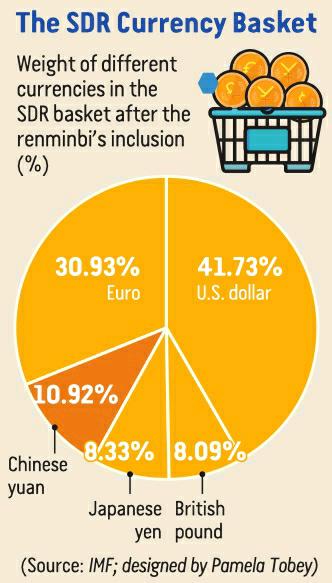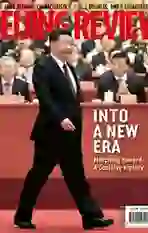Welcome Changes Underway
2017-11-09ByDengYaqing
By+Deng+Yaqing
One year has elapsed since Chinas currency, the yuan or renminbi, was offi cially included into the International Monetary Funds (IMF) Special Drawing Rights(SDR) basket of currencies. Gaining the IMF reserve status marked a significant step in the internationalization of the yuan.
The SDR is a synthetic reserve currency created by the IMF in 1969 to supplement its member countries official reserves, and the value of the SDR is based on a basket of major currencies. SDRs are allocated to IMF members from time to time, based on each countrys quota in the IMF, and the baskets composition is reviewed every fi ve years.
“The yuans inclusion in the SDR currency basket signifies that the yuan has been formally recognized as an international currency that can be used freely, which has greatly shored up its credit ranking and facilitated its extensive use,” said Xu Hongcai, Deputy Chief Economist of the China Center for International Economic Exchanges, in an interview with Beijing Review.
According to statistics from the Society for Worldwide Interbank Financial Telecommunication, by the end of June 2017, the yuan ranked sixth, third and fifth in payments, trade financing and foreign exchange transactions in the world, and roughly 56 overseas central banks and monetary authorities held yuan-denominated fi nancial assets and had taken it as a reserve currency.
However, Xu noted that the yuan is now primarily used in trade and only accounts for slightly over 1 percent of the worlds total international reserves. “The yuans internationalization lags behind the elevation of Chinas economic status and falls short of the international communitys expectations. Therefore, further efforts should be made to advance the internationalization process,”said Xu.
“As long as Chinas economic funda-mentals are favorable, foreign trade keeps growing steadily, and offshore yuan usage is on the increase, the internationalization of the yuan will carry on unremittingly,” Sun Jie, a research fellow with the Institute of World Economics and Politics under the Chinese Academy of Social Sciences, told Beijing Review.
Steady progress
In the past year, Chinas capital market opened wider to the outside world by kicking off the Shenzhen-Hong Kong Stock Connect and Bond Connect schemes. According to the China Foreign Exchange Trade System, net northbound capital flow through the Shanghai- and Shenzhen-Hong Kong stock trading links, which were started in November 2014 and December 2016 respectively, totaled 25.48 billion yuan ($3.85 billion) in September. Moreover, the volume of yuan-denominated bonds held by foreign institutions increased 96.1 billion yuan($14.52 billion) to 1.06 trillion yuan ($160.12 billion), with the single monthly increment hitting a record high.endprint
“Overseas investors are seeking channels to invest in the mainland, which in turn pushes forward the internationalization of the yuan,” said Sun, who believes that as long as the yuan becomes increasingly internationalized and recognized by other countries, the fl ow of offshore yuan will continue going up and restrictions will be reduced.
Aside from that, due to factors such as the increase of outbound direct investment in the past year, uncertain foreign expectations about Chinas economic growth and the U.S. Federal Reserve raising its interest rates, the exchange rates of the yuan and many other currencies have experienced ups and downs in the past year, said Sun.
Statistics show that since the beginning of the year, the yuan has appreciated by over 4 percent against the U.S. dollar, the same as other currencies in the SDR basket.
Sun claimed that, “in order to curb speculation, Chinese authorities have unveiled countercyclical regulations. As the yuans internationalization keeps moving forward, its transaction volume should become larger, and speculation less likely.” Sun suggested that joining the SDR basket made Chinas central bank and the State Administration of Foreign Exchange (SAFE) release policies and measures facilitating the healthy development of the foreign exchange market.
In the future, the exchange rate of the yuan will be more elastic, said Lu Lei, Deputy Director of SAFE, at a forum on the yuan and foreign exchange market in Beijing on September 13. Lu also noted that the yuan exchange rate formation mechanism will be based on market supply and demand.
Future direction
More and more countries, especially those along the Belt and Road, have shown a willingness to use the yuan as a reserve currency or in transactions, said Laura M Cha, Chairwoman of the Hong Kong Financial Services Development Council, at a forum held in Hong Kong on September 11. She noted that these efforts are at a nascent stage and that analysts still need to wait and see the results of the yuans internationalization.
To advance the process, China has to boost the opening up of capital accounts and increase the elasticity of the yuan exchange rate. However, the more volatile the yuan, the greater the risk, said Xu, who suggested that domestic industrial and commercial companies, as well as the countrys financial system, are not strong enough to bear radical reform of the yuan exchange rate formation mechanism.
Xu said that in order to further open up the channel between domestic and foreign capital markets, more Panda bonds—yuan-denominated bonds from non-Chinese issuers—should be circulated, and the listing of foreignfunded companies on the Shanghai Stock Exchange should be promoted.
“Chinese authorities should consider accelerating the release of crude oil and iron ore futures that allow foreign investors to trade, because the country needs to have a larger say in the transactions of those imports,” said Xu.
Nonetheless, there are still challenges ahead. In the near term, Chinese fi nancial institutions should increase their overseas business offices and expand the network of offshore yuan centers, not just in traditional financial hubs like London, Paris, New York, Singapore and Toronto, but also in emerging financial markets such as Sao Paulo, Moscow, Bombay and Johannesburg, said Xu.endprint
